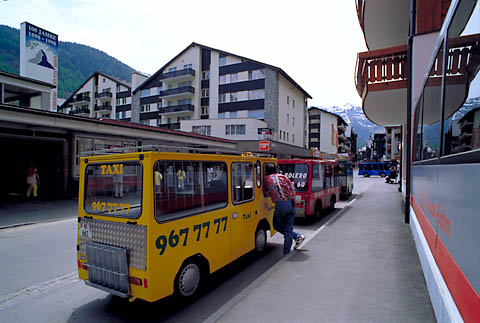  Small, slow electric taxis in Zermatt, Switzerland. Conventional automobiles are not allowed in the city.
External CombustionSome form of external combustion (or non-fuel-based motive power) could eliminate urban automobile emissions entirely. Some day, sustained nuclear fusion may be achieved, at which time energy and air pollution concerns should pretty much disappear. Even the electric car powered by fossil-fueled power plants answers this concern - its emissions are relocated to a static external combustion engine, most likely located outside the city. (Emissions from static sources are also cheaper and easier to control.)Safety EnforcementCompute-equipped cars offer many opportunities for regulation and taxation of use, many of which will be opposed in the interest of protecting privacy. However, computerization offer the possibility of direct safety enforcement - the computer limits the vehicle's speed to what is safe and forces the driver to stop if his behavior is dangerous. While such interference might be resented, it need not invade privacy.Computerized GuidanceSome form of computer-guided automobile is likely to see at least a large-scale trial. In cities such as Los Angeles, computer-controlled cars might travel three times faster during rush-hour than now. Assuming it actually works and the price is reasonable, computer-guided cars would increase both the speed and carrying-capacity of existing freeways. Safety should improve and pollution (for a given number of vehicle-miles) should decline. Experience indicates, however, that any increase in available capacity and average speed will be rapidly absorbed, leading to still more vehicles traveling ever farther.Underground StreetsAt enormous expense, it would be possible to bury the automobile infrastructure, reclaiming the city surface for people. The cost of putting a public transport system underground is large but still a tiny fraction of the cost of burying the entire street and highway network of a city based on road transport.Suppose It Works?Technology might solve the congestion, pollution, esthetic, and safety issues related to automobile use in cities. This does not mean that the car is the best solution, and it is almost certainly the most expensive and resource intensive. |
Back to More
Return Home
About the book: Carfree Cities
E-mail
carfree.com
Copyright ©1996-2002 J.Crawford